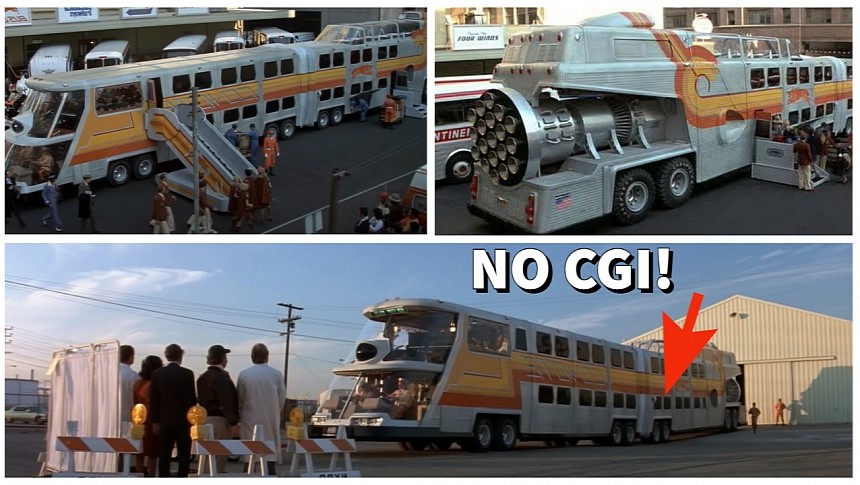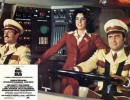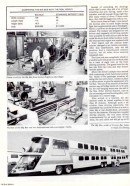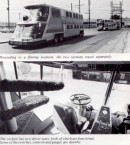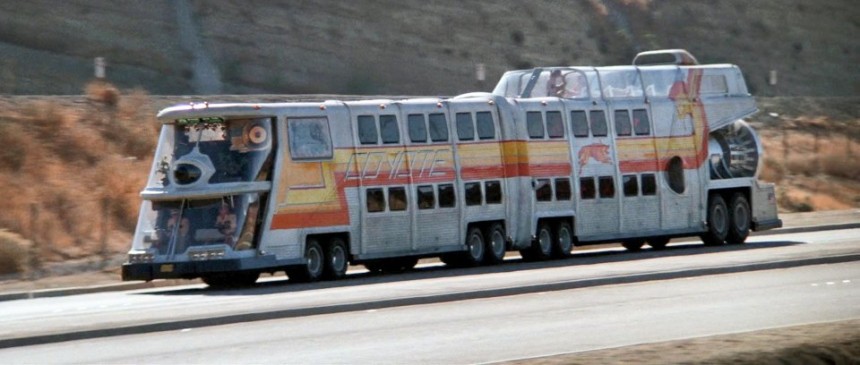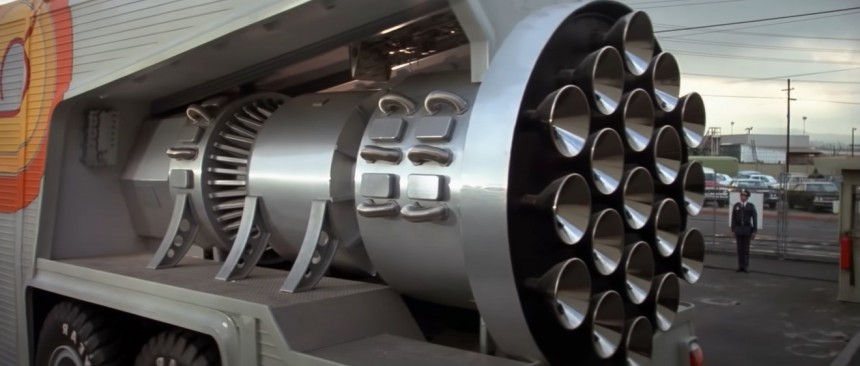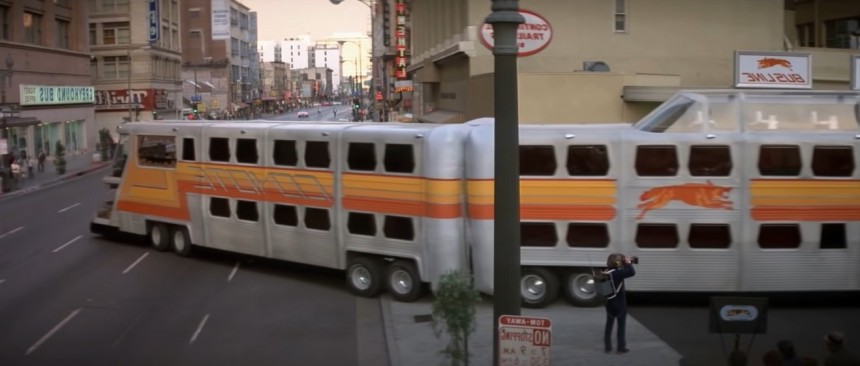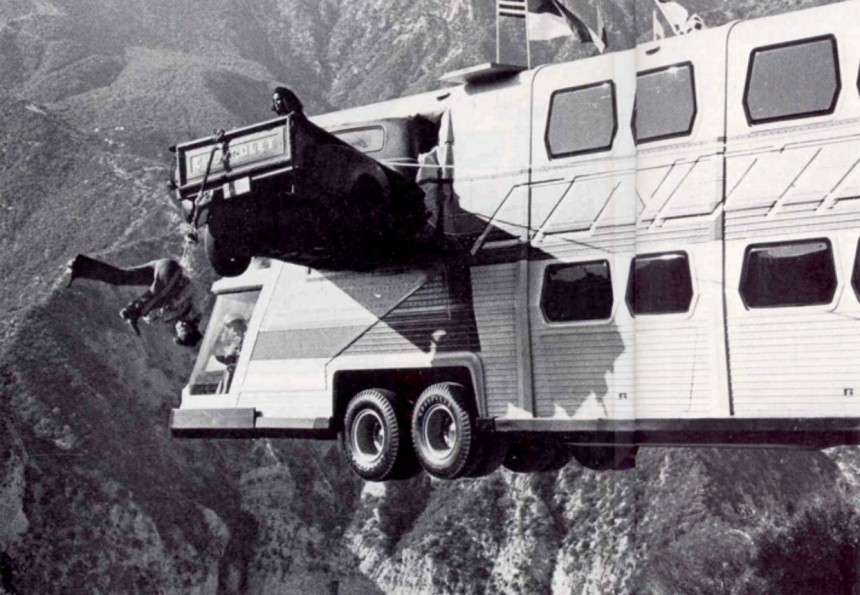For movie buffs who love the dedication of someone like director Christopher Nolan to stick only to practical effects and not include any CGI (computer-generated images) in their movies, this one's a doozy. This is Cyclops, the most ridiculous and awesome functional movie prop ever created.
Back in the day when cinema wasn't so reliant on CGI for effects, technicians were forced to tackle whatever problem came their way with lots of imagination and just about as much building skill. Shooting scenes with scale models or against a blank screen to which they later imposed a moving image was the norm, just as was building custom vehicles for movies.
As regards building custom vehicles, this was the true golden era of cinema. The CGI of recent years has brought us some of the most memorable car action scenes of all time, but the pre-CGI years were when the most iconic movie vehicles were built. Cyclops is one such vehicle, even if you might have never heard of it before now – or, for that matter, seen the movie that made it so famous.
Cyclops is a ridiculous but awesome bus from the equally ridiculous (and awesome) movie The Big Bus, which came out in 1976. It's a spoof disaster film incorporating tropes from a series of disaster flicks that had made a killing (ha!) at the box office in the preceding years. Like all spoof films, it started on the premise that it had to be as ridiculous as possible while still maintaining a slight degree of realism.
The Big Bus was neither a big draw with the public nor a critical hit for Paramount Pictures, though not for lack of trying on behalf of the studio. Its artistic value has since been reconsidered, and it's now widely regarded as one of the best comedies of the '70s. Cyclops is a major reason why it's so amazing: a double-deck, nuclear-powered bus slash landyacht of the kind we’ll never see again.
In the film, Cyclops is the equivalent of a cruise liner traveling on land – or the wheeled version of the train in Snowpiercer, if you like your comparisons strictly from the world of cinema. It was a monster landyacht that offered luxury features and astounding performance, invented specifically for the purpose of traveling non-stop between New York and Denver. Owned by Coyote Bus Lines, it was nothing like the real-life Greyhound Lines buses: massive in both length and height, it was a self-contained unit that could easily break the wind barrier at 90 mph/145 kph ("we’re breaking wind at 90!" is perhaps one of the funniest lines in the film), and boasted incredibly futuristic features.
These included an automatic tire changer that allowed changing a wheel as the bus traveled at speed, ditching the defective unit to the side of the road. There was also an automatic window washing system that could be operated as the bus traveled, allowing guests onboard the perfect view at all times. Amenities ranged from an Asian-style bar in the lounge over the cockpit to a bowling alley, a pool, and a full-size restaurant.
But the most impressive thing about Cyclops was the reactor on the front end, which allowed it to travel without stopping to refuel. By the way, the name Cyclops came from the giant extra driving light in the front.
In real life, Cyclops wasn't nuclear-powered, but that doesn't mean it was any less impressive. It wasn't a bus but two International cab-over-engine trucks joined together at the articulated part to create the illusion of a single articulated unit. With a total length of 110 feet (33.5 meters) and a height of 18.3 feet (5.5 meters), not including the removable glass canopy on the rear section, Cyclops cost Paramount a whopping $500,000 to build – so about $2.7 million in today's money, adjusted for inflation.
The Cyclops was destroyed after production was complete, so the only surviving testimony of its existence (aside from the movie) is a story in the now-defunct Bus Life magazine, where it was described as "one of the corniest land vehicles ever conceived." This makes the fact that it was built without a proper design study all the more impressive. Gaile Brown and Lee Vaque, heads of Construction and Special Effects Departments at Paramount, were in charge of the project, which included "a lot of head scratching and arm waving, […] a few mistakes, and […] enough things right."
The front-end unit was completely modified by the time the project was finished. The International engine was replaced with a Ford one, and the manual transmission switched for an Allison automatic. The front axle was also rebuilt as a tandem with dual tires, and the chassis was modified, but initially, the front unit was driveable from either side since it had dual controls, like in the movie. The Cyclops had 32 wheels in total, with the front ones on each unit moving independently. Indeed, there was a driver in the rear unit as well, but he had no road visibility and had to be guided via audio link by the first driver on how to steer.
Putting the two pieces together to form the bus took less than 45 minutes, and the units would travel separately to shooting locations across the greater Los Angeles area, joining only when cameras rolled. In case of an emergency, the second driver had a quick-release lever he could pull to detach from the front end and steer to safety.
Much of what is seen of Cyclops on the screen didn't exist in real life, though the second-level lounge bar was fully functional. There were seats by each of the windows to create the impression that the bus was loaded with passengers, but the rest of the space was empty, occupied by a steel frame that was necessary to hold the bus in place in the final cliff-hanging scene. The bowling alley and the pool only existed on the Paramount studio set. A bummer, we know.
Apparently, the Cyclops was a chore to drive in single-unit mode, but it could be done with the proper coordination and attention between the two operators. Even so, it was still able to hit 65 mph (105 kph), which it did more than on one occasion. Hey, it's not breaking wind at 90, but it's still impressive.
Less impressive is how little use it got outside of the production. The bus never left the LA area except for a one-time trip to San Diego, where Paramount bosses had put together a promotional event for the film. The vehicle was scrapped soon after – a shame considering how much money it had cost, and even more so if you think of how amazing it had turned out.
As regards building custom vehicles, this was the true golden era of cinema. The CGI of recent years has brought us some of the most memorable car action scenes of all time, but the pre-CGI years were when the most iconic movie vehicles were built. Cyclops is one such vehicle, even if you might have never heard of it before now – or, for that matter, seen the movie that made it so famous.
Cyclops is a ridiculous but awesome bus from the equally ridiculous (and awesome) movie The Big Bus, which came out in 1976. It's a spoof disaster film incorporating tropes from a series of disaster flicks that had made a killing (ha!) at the box office in the preceding years. Like all spoof films, it started on the premise that it had to be as ridiculous as possible while still maintaining a slight degree of realism.
In the film, Cyclops is the equivalent of a cruise liner traveling on land – or the wheeled version of the train in Snowpiercer, if you like your comparisons strictly from the world of cinema. It was a monster landyacht that offered luxury features and astounding performance, invented specifically for the purpose of traveling non-stop between New York and Denver. Owned by Coyote Bus Lines, it was nothing like the real-life Greyhound Lines buses: massive in both length and height, it was a self-contained unit that could easily break the wind barrier at 90 mph/145 kph ("we’re breaking wind at 90!" is perhaps one of the funniest lines in the film), and boasted incredibly futuristic features.
These included an automatic tire changer that allowed changing a wheel as the bus traveled at speed, ditching the defective unit to the side of the road. There was also an automatic window washing system that could be operated as the bus traveled, allowing guests onboard the perfect view at all times. Amenities ranged from an Asian-style bar in the lounge over the cockpit to a bowling alley, a pool, and a full-size restaurant.
In real life, Cyclops wasn't nuclear-powered, but that doesn't mean it was any less impressive. It wasn't a bus but two International cab-over-engine trucks joined together at the articulated part to create the illusion of a single articulated unit. With a total length of 110 feet (33.5 meters) and a height of 18.3 feet (5.5 meters), not including the removable glass canopy on the rear section, Cyclops cost Paramount a whopping $500,000 to build – so about $2.7 million in today's money, adjusted for inflation.
The Cyclops was destroyed after production was complete, so the only surviving testimony of its existence (aside from the movie) is a story in the now-defunct Bus Life magazine, where it was described as "one of the corniest land vehicles ever conceived." This makes the fact that it was built without a proper design study all the more impressive. Gaile Brown and Lee Vaque, heads of Construction and Special Effects Departments at Paramount, were in charge of the project, which included "a lot of head scratching and arm waving, […] a few mistakes, and […] enough things right."
Putting the two pieces together to form the bus took less than 45 minutes, and the units would travel separately to shooting locations across the greater Los Angeles area, joining only when cameras rolled. In case of an emergency, the second driver had a quick-release lever he could pull to detach from the front end and steer to safety.
Much of what is seen of Cyclops on the screen didn't exist in real life, though the second-level lounge bar was fully functional. There were seats by each of the windows to create the impression that the bus was loaded with passengers, but the rest of the space was empty, occupied by a steel frame that was necessary to hold the bus in place in the final cliff-hanging scene. The bowling alley and the pool only existed on the Paramount studio set. A bummer, we know.
Less impressive is how little use it got outside of the production. The bus never left the LA area except for a one-time trip to San Diego, where Paramount bosses had put together a promotional event for the film. The vehicle was scrapped soon after – a shame considering how much money it had cost, and even more so if you think of how amazing it had turned out.
